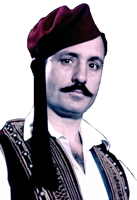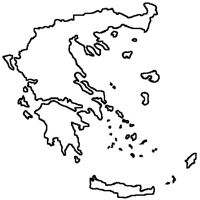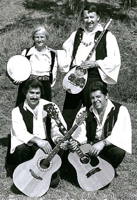
|
The Society of Folk Dance Historians (SFDH)
Greek Folk Music and the Dance
[
Home |
About |
Encyclopedia | CLICK AN IMAGE TO ENLARGE |

|
 The tradition of music in Greece goes back thousands of years. It is part of a national heritage, treasured by the Greek people like a precious heriloom from ancient Greece, since this divine gift was entrusted to them by Apollo, and the parton muse Terpsichore presided over their dances.
The tradition of music in Greece goes back thousands of years. It is part of a national heritage, treasured by the Greek people like a precious heriloom from ancient Greece, since this divine gift was entrusted to them by Apollo, and the parton muse Terpsichore presided over their dances.
To this very day, music is an inseparable part of the Greek life. In his dances and songs, the Greek gives vent to his dramatic expression to glorify his joys, to wallow in his sorrows, and above all, to record his aspirations, the history and lore of his people, and to store up legends and folktales.
Greek music is a superb combination of the elements of ancient Greek music, a theoretical basis of scales and rhythm forms, some oriental influences, perhaps brought over from the expeditions by Alexander the Great and fused together under some mannered conditions from the Byzantine life and post-Byzantium ages. It is definitely, with very few exceptions, entirely free from any of the characteristics found in Western music. These exceptions can be traced to particularly, the Ionian Islands that are between Greece and Italy, and mostly due to the influence of the Venetian reign which successively assimilated in the lifestream of European thought and art. The Ionian Islands remained under Venetian ryle or influence until very late in the 19th century.
The musical instruments that provide accompaniment to the national dances and songs of Greece fall familiarly into the three principal categories:
- Stringed instruments: Lyra (a kind of medieval fiddle); violin' lute; santouri (or dulcimer); mandolin; bouzouki (a Greek string instrument with either three or four sets of two strings); and bass guitar.
- Wind instruments: Pipiza (a primitive, exceedingly sharp double-reed instrument); cornemuse, gaida, and askamandoura (bagpipes); clarinet; aulos (an ancient Greek instrument); pastoral flutes; and zurna (a reed pipe).
- Percussion instruments: tympanon (small hand drum); davouli (large primitive handmade drum); bells; triangles; defi (small tambourine); krotalas (wooden spoons); and zils (finger cymbals).
 The lyra is largely concerned with the music belonging to the Black Sea or Pontus area, the island of Crete, and of the Dodecanese. The cornemus belongs to the mainland provinces of Greece and certain other islands. The violin, the clarinet, and the lute most frequently used in association with the santouri, are the instrumental group most widespread in the country. Another group, known as "zygia" or "compania," has taken place of an old combination still surviving in some parts of Greece that consists of one pipiza and one davouli.
The lyra is largely concerned with the music belonging to the Black Sea or Pontus area, the island of Crete, and of the Dodecanese. The cornemus belongs to the mainland provinces of Greece and certain other islands. The violin, the clarinet, and the lute most frequently used in association with the santouri, are the instrumental group most widespread in the country. Another group, known as "zygia" or "compania," has taken place of an old combination still surviving in some parts of Greece that consists of one pipiza and one davouli.
Instrumentation was never too elaborate and never more than a contingent group of about four or five players offereing the music. These people were not referred to as "professional" musicians, in that they had their regular work and music was their sideline, in the true folk idiom. They almost invariably remained in the center of the dancing circle and in real folk fashion, interpreted songs to suit the tastes of the feast or of the dancers, and each song was played at never any given length. Inspiration and the muse was their guide. Payment was not considered except whatever people wanted to donate as a mere gesture.
The folk dances of Greece are accompanied by music played on these traditional instruments, and also sometimes with a song. The dances for the most part fall into two classifications: the very lively "Pidiktos" and the more restrained "Syrtos." The Pidiktos' are the jumping and leaping dances, the Syrtos are the smooth-flowing, "dragging" dances. The other category is of the mixed dances dances where they alternate from Syrtos to Pidiktos and back again. The most common trait, however, is that they will begin slow and quaint and then build up to the leaping and jumping style.
The leaping of the Pidiktos is indicative of the rugged mountains of Greece. There, the life is bolder and the very strain of mountain life is depicted in the movements, especially in the virile and stark movements of the men. The high raising of the legs and the leaps in the air almost seem to rise to the need of a man to challenge nature, and there are expressions of a dancer, either during a dance or in describing it afterwards, how he leaped over the mountains in his dancing. The Syrtos, or dragging dances, are usually seen in the lowlands, on the coastal regions, and of course, on the islands. These dances tend to characterize the more peaceful landscape and lyrical moods of the seashore and the tender, easy-going Aegean Sea.
In areas where there are dramatic changes in the landscape and where both qualities of the valleys and of the mountains are mixed, we see a peculiar mixture of these qualities, described in movement. Most Pidiktos dances are danced specifically by men, whereas the Syrtos are done by both men and women. Circular dances are an imperative characteristic of all Greek folk dances, a form still found in the Greek villages where the dancing is done most often at the "threshing floor: after the harvest, and has retained this very common form for various reasons. The circle is the symbol of infinity, and to progress, dancing in a circle always gives you a focal point of access in the dance where, if we were to dance in a straight line, we must be confronted with going and then returning. The threshing floor after the harvest then became the "orchestra" (dancing place), named after the ancient Greek word for dance, "orchesis." The dances were very often named after the place where they were first developed into a recognized form or variation, such as the "Pelioritikos" from Pelion; "Tsakonikos" from Tsakonia; "Samiotikos" from Samos; or "Haniotikos" from Hania on Crete.
Dances were also named after a profession or trade such as "Hasapikos, the butchers' dance, the origin of which is traced back to the Byzantium age when, in Byzantium (Constantinople), the members of the Butchers' Guild, after slaughtering the swine, and steeped in blood, dance wildly in the streets as a manner of exorcising their slaughter. There are dances that still denote the professional name such as the hunter's dance, later known as "Kastrianos" because of the fact that the hunting referred to was mainly done in that area. Another dance in Greek Macedonia, the "Kounelakia" (rabbit) also imitates the movements.
Finally, some dance names denote the category to which they belong, such as "Klephtikos" (or "Klephtic") tht is the warrior patriot's dance. This dance, which is at times danced with sword in hand, utilizes the interpretation of the warrior stimulating his sinews in order to enter into battle. Other movements are when the sword is eliminated, uses the arm movements swinging in the air as if it were a sword, slapping the heels to show cuts and thrusts, or the dance lies on the floor, bending backwards as if he were wounded, or leaps into the air to rise victorious.
Generally speaking, the women dancers of Greece, according to ancient habit, still dance "demurely with downcast eyes," though vibrant and free, and expressing a sensitive and delicate joy, for the women will emphasize it to show in the dance their grace and beauty, while their costume or dress will have the finest embroidery, weaving, and sense of artistry in depicting the world around her, a world steeped in tradition and a lore to be cherished and disseminated. The man, in sharp contrast, will perform in all manner of agile steps and leaps, springing low and high with twisting turns, improvising a personal choreography with an astonishing ingenuity in a way that he would meet the trails and tribulations of agrarian life, yet still retain with absolute respect, the formal rhythms and the rigid adherence found in all Greek dance melodies.
The dances of Greece are distinctively placed into different area groups. There are some dances though, that have become Pan Hellenic, meaning that in essence, all Greeks everywhere dance them. Such a dance is the "Kalamatiano (in 7/8 meter)," which though originated in Kalamata, Peloponessus, has spread with a great rapidity to all of Greece. Another that shares this kind of acceptance is the "Tsamiko" (or "Klephtiko") which became important during the struggle of Ottoman rule in the 1800s. Most recently, that kind of popularity is being shared by the various styles of "Hasapika" dances. Otherwise, dances are broken down according to region.
Macedonia is one such region which, though within the province there are still villages or areas that entertain similarity, as a rule, Macedonian people have a style that is particular to them. Another such region is Thrace. Epirus, too, is well known for its many and great variety of dances, but interesting enough, though each dance has a different stepping, their style of pausing and holding and leapling is strictly theirs. The plains of Thessaly bear another kind of movement attitude, the sedate ease of the nomadic tribes. Roumeli and Peloponessus were brought closer together, since they were the forebears in creating the new nation of Greece.
The Greek Islands also have their own customs, songs, music, costumes, and traditions and can be seen very clearly in such large islands as crete and Cyprus. The twelve major islands of the Dodecanese group, though each has its own dance, have a great cultural similarity. The same is true of the other groups of islands, the Cyclades, the Sporades, and most definitely among the Ionian Islands. Other islands were either large enough and could be independent, retained their own cultural identity, such as Samos, Chios, Ikaria, or Lesbos (Mytilene).
The dance and songs of Pontos, however, an extensive tract of country along the southern shore of the Black Sea, have won a special place of their own in Greek folk dance and music. These people, who were cut off for several thousand years from having much contact with their fellow Greeks on the peninsula we know of today as Greece, lived in an isolation and culturally they retained with almost crystal purity, their earliest traditions of language, religion, song, and dance, as a means of the strongest motivation of identity known. Their dances have a particular quality, different from the rest of Greece. Some are lyrical, some dithryambic, and others, like the dance "Serra," martial. the "Serra," which is exclusively a Pontic dance, has a pyrrhic theme leading up to a display of sword fighting. There is a description of this dance in Homer's "Iliad," that famous epic poem in the lines describing the embossed decorations on Achilles' shield – ". . . and young men were whirling in dance, and among them, flutes and viola sounded high . . . Also did the glorious lame god devise a dancing-place like unto that which once in wide Knossos Daidalos wrought for Ariedne of the lovely tresses. Fine linen the maidens wore and the youths well-woven doublets glistening in oil. Fair wreaths had the maidens, and youths daggers of gold hanging from their silver baldricks. And now they would run around with deft feet, exceedingly lightly . . . and now anon they would run in lines to meet each other and great company stood round the lovely dance in joy . . ."
DOCUMENTS
- Athan Karras, an article.
- Greece, a country.
Used with permission of the author.
Printed in Folk Dance Scene, October 1975.
This page © 2018 by Ron Houston.
Please do not copy any part of this page without including this copyright notice.
Please do not copy small portions out of context.
Please do not copy large portions without permission from Ron Houston.